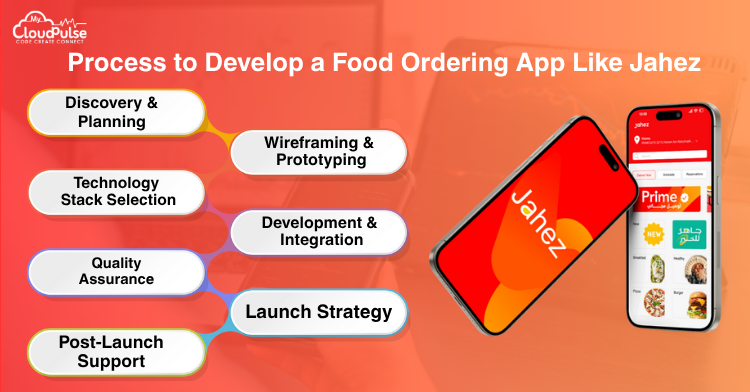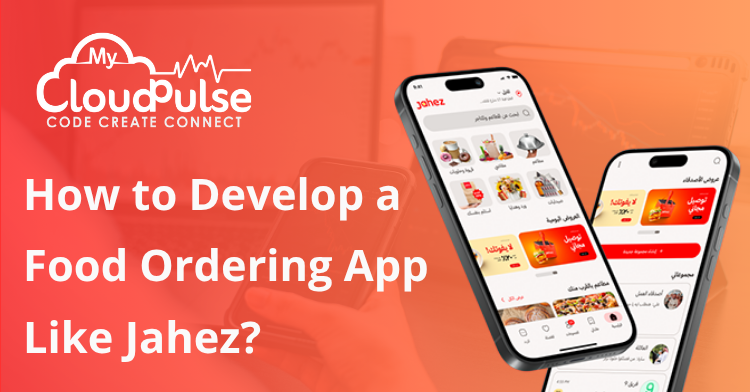In today’s fast-paced, digitally connected world, the way people eat has transformed dramatically. No longer confined to cooking at home or dining out, consumers increasingly prefer the convenience of ordering food with just a few taps on their smartphones. This shift in behavior has given rise to a multibillion-dollar online food delivery industry, prompting many entrepreneurs to explore how to develop a food ordering app like Jahez—a platform that has led the charge in the Middle East with its localized services and seamless user experience.
Founded in Saudi Arabia, Jahez has carved a unique space in the food delivery ecosystem. With a localized focus, smooth user experience, and seamless technology, it’s no surprise that the app has become a go-to platform for food lovers and restaurant owners alike. If you’re considering building a similar platform, this blog post is your comprehensive guide. From core features and advanced technology to the estimated cost and team structure, we’ll walk you through every essential element needed to build a food ordering app like Jahez.
App Stats
Understanding Jahez’s performance provides key insights into what success looks like in this space. It also helps you benchmark expectations and establish measurable goals for your app. Here are some noteworthy stats and facts:
- App Name: Jahez
- Category: Food & Drink
- Platform: Android & iOS
- Availability: Primarily in Saudi Arabia; expanding to other Gulf countries
- Downloads: 5 million+ downloads on Google Play Store
- User Rating: 4.2 stars out of 5 from over 100,000 reviews
- Launch Year: 2016
- Funding: Over $36 million raised as of 2021
- Valuation: Estimated at over $2 billion after IPO in Saudi Arabia’s Nomu market
These stats show that Jahez is not just an app but a business empire in the making. It has successfully tapped into local preferences while maintaining high standards of service, functionality, and user experience.
Key Highlights
Let’s dive into the standout features and differentiators that make Jahez unique:
Localized Service
Jahez provides a hyper-localized user experience, customized to the cultural, linguistic, and behavioral norms of its primary user base. From Arabic language support to delivery schedules accommodating religious practices like prayer times and fasting hours during Ramadan, this level of localization creates strong brand loyalty.
Ease of Use
The app boasts an intuitive UI/UX that caters to all age groups. Whether you’re a teenager ordering snacks or a senior citizen craving traditional meals, the app’s simple navigation, large icons, and clear CTAs make it user-friendly across demographics.
Efficient Delivery Network
With its robust logistics backend, Jahez ensures timely delivery through real-time GPS tracking and optimized driver routes. The company often partners with local delivery services, keeping costs low while ensuring high efficiency.
Advanced Notification System
Users receive timely alerts on every step of their order—from confirmation to preparation and delivery. The “driver approaching” notification is especially appreciated by users who want to be ready when their food arrives.
Review System
Customer feedback plays a central role in the app’s operations. The review and rating system helps users make informed choices and also holds restaurants accountable for quality and timeliness.
Essential Features to Develop a Food Ordering App Like Jahez
A fully functional food delivery app like Jahez must offer features that serve users, restaurant partners, and delivery personnel alike. Here’s a detailed look at core functionalities:
User Registration and Onboarding
Offer multiple sign-up options such as email, phone number, or social media accounts. A one-time password (OTP) verification system enhances security and ensures authentic user profiles.
Address and Location Management
Let users save multiple addresses—home, work, or custom—to make reordering faster and easier. Use GPS to auto-detect locations and offer address auto-fill suggestions.
Restaurant Discovery
Showcase restaurants based on user location. Enable search filters for cuisine types, ratings, delivery time, distance, and promotions. Include high-quality images of menu items to influence decision-making.
Menu Customization
Allow users to customize meals with add-ons, special instructions, or allergy notices. Restaurants should be able to update item availability and prices in real time.
Seamless Checkout Process
Incorporate multiple payment methods including credit/debit cards, digital wallets, net banking, and cash on delivery. Offer promo codes, coupons, and loyalty rewards at checkout.
Order History and Reordering
Provide access to past orders with a quick reordering option. Include details like price, order date, and restaurant name for user convenience.
Real-Time Order Tracking
Display the status of orders through every stage—confirmed, being prepared, picked up, and out for delivery. Integrate with map APIs for live driver tracking.
Ratings and Reviews
Enable users to rate and review food, delivery experience, and the app interface. These reviews can be crucial for quality control and building community trust.
Customer Support
Integrate a support system with live chat, FAQs, and support ticket generation. Offer easy access to refund and dispute options.
Advanced Features to Develop a Food Ordering App Like Jahez
Beyond the basics, adding advanced features can significantly improve user retention and operational efficiency. Here’s what you should consider:
Artificial Intelligence for Personalization
Use AI to personalize the homepage with food suggestions, restaurant recommendations, and offers based on the user’s past orders, behavior, and time of day.
Voice Search Integration
Integrate voice search to enhance accessibility, especially for users who are driving or multitasking. Allow food item searches and voice-based checkouts.
Loyalty & Rewards System
Gamify the experience by offering points for every order, which can be redeemed for discounts or free meals. Display a user’s rank (e.g., Gold, Platinum) to encourage more spending.
Contactless Delivery Option
Provide a checkbox during checkout for “Leave at the door” delivery. Include a note field for users to give specific instructions to drivers.
Multi-Language and Multi-Currency
If your app is targeting a diverse audience, add language options (e.g., English, Arabic, French) and currency settings to make the app more inclusive.
Analytics Dashboard for Restaurants
Equip partner restaurants with a comprehensive dashboard to view sales, customer feedback, peak order times, and menu performance.
Fleet Management for Drivers
Offer drivers a separate interface with route optimization, order queues, payment tracking, and communication tools for real-time updates.
Monetization Models
Here are several monetization strategies to ensure your app generates sustainable revenue:
Commission-Based Model
Charge restaurants a percentage (typically 15–30%) on each successful order. This is the most common and reliable income stream.
Delivery Charges
Users can be charged a flat or distance-based delivery fee. Dynamic pricing can be applied during high-demand times or adverse weather conditions.
Subscription Plans
Offer users a monthly or yearly subscription (like “Jahez Plus”) for perks such as zero delivery charges, early access to deals, and priority support.
Advertising and Promotions
Allow restaurants to pay for featured listings, banner ads, or promotional placements within the app to gain more visibility.
Data Monetization
Aggregate user data (without compromising privacy) to provide market insights to partner restaurants or other stakeholders.
Process to Develop a Food Ordering App Like Jahez
Developing a food delivery app involves strategic planning, execution, and iteration. Here’s a step-by-step breakdown:

1. Discovery & Planning
Conduct competitor research, identify your target demographic, and define your unique selling proposition (USP). Create user personas and define user stories to guide development.
2. Wireframing & Prototyping
Design the app flow and interface using wireframes and mockups. Test these designs with potential users to validate assumptions.
3. Technology Stack Selection
Choose the tech stack that aligns with your needs. React Native for mobile apps, Node.js for backend, MongoDB/PostgreSQL for database, and AWS for cloud services are common picks.
4. Development & Integration
Build modules for user login, restaurant discovery, payment gateways, tracking, and notifications. Use APIs for maps, analytics, and payment processing.
5. Quality Assurance
Perform end-to-end testing: unit testing, integration testing, UI/UX testing, and load testing to ensure a smooth and bug-free user experience.
6. Launch Strategy
Prepare for app store submissions, promotional campaigns, and PR outreach. Launch an MVP first and scale based on feedback.
7. Post-Launch Support
Continuously monitor app performance, resolve bugs, release updates, and collect user feedback to refine features.
Cost to Develop
Here is a detailed cost estimate to build a food delivery app similar to Jahez:
| Development Phase | Estimated Cost (USD) |
| UI/UX Design | $5,000 – $10,000 |
| Mobile App Development | $15,000 – $25,000 |
| Backend Development | $15,000 – $30,000 |
| Admin Dashboard & Reporting | $5,000 – $10,000 |
| QA and Testing | $4,000 – $8,000 |
| Third-Party Integrations | $3,000 – $8,000 |
| Launch & Marketing | $5,000 – $12,000 |
| Total Estimate | $52,000 – $103,000 |
Note: These are ballpark figures and can vary based on geography, team type (freelance vs agency), and scope.
Team Structure
To execute this complex project, you’ll need a team that includes:
- Project Manager – Oversees development timelines and coordination.
- UI/UX Designer – Crafts visually appealing and user-friendly interfaces.
- Mobile App Developers – Build the iOS and Android apps (preferably using cross-platform tools).
- Backend Developer – Handles server-side operations and database management.
- QA Engineer – Ensures that the app functions smoothly across all devices.
- DevOps Engineer – Manages cloud deployments, CI/CD pipelines, and app scalability.
- Marketing Strategist – Plans the launch campaign, user acquisition, and retention strategies.
- Customer Support Lead – Manages feedback, queries, and complaints from users and partners.
Conclusion
The online food delivery market is ripe with opportunities, and Jahez is a shining example of how to localize and scale successfully. With the right combination of core and advanced features, a clear monetization strategy, and a skilled team, you can build a food ordering platform that not only competes but thrives.
Building an app like Jahez requires more than just tech expertise—it demands cultural awareness, operational efficiency, and a long-term vision. Start small, test fast, and scale smart.
FAQs
An MVP can take around 4 to 6 months, while a fully-featured, scalable app may take 8 to 12 months depending on the complexity and resources.
No. You can partner with local delivery services or build a network of freelance drivers using gig economy models.
Ensuring real-time tracking, managing logistics, maintaining food quality, and handling high volumes of user data securely are some of the key challenges.
Yes, and it’s advisable. Supporting multiple gateways (Stripe, PayPal, local wallets) enhances accessibility and convenience for users.
Focus on loyalty programs, regular discounts, personalized recommendations, and top-notch customer service to build long-term engagement.



